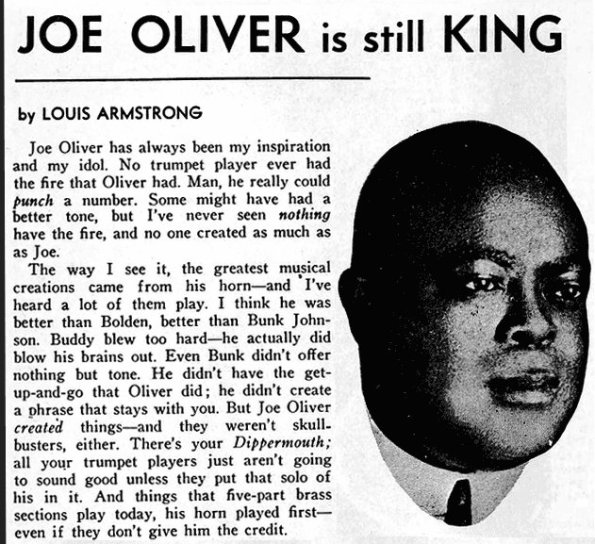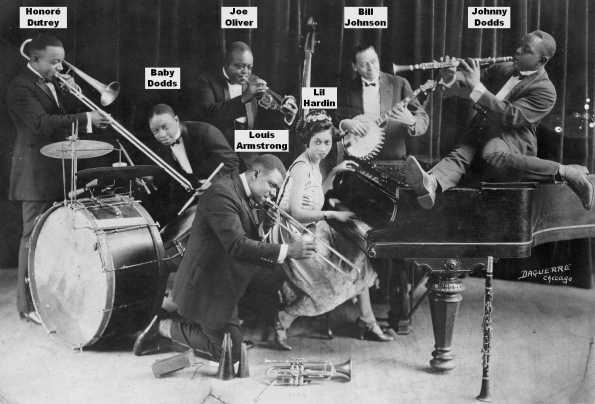New Media Timeline: King Oliver’s Creole Jazz Band, 1917-1923
I’ve always been fascinated with visualizations of historical events (action within time and space), and even more so with the failure of circumscribed media projects to adequately represent history.
Historical narrative is always artificial, and timelines compound this by being streamlined and projecting a linear clarity, which can obscure the messiness that underlies real events.
So (of course) I’m building one!
Timeline of King Oliver’s Creole Jazz Band (1917-1924)
I’ve finally decided to post about my in-progress timeline, which follows the development of King Oliver’s Creole Jazz Band (“KOCJB”) from 1917 through 1923, the year the band made 39 recordings which constitute “the first recordings of substance by an African-American jazz band [and] the most significant corpus of early recorded jazz” (Gene Anderson, U. Richmond).
While cornetist Joe “King” Oliver was an important pioneer of Hot Jazz in his own right, today he is remembered because his protégé was none other than Louis Armstrong, the most important (and best, IMO) musician of the “Jazz Age” (Armstrong’s period of seminal influence really extended from 1925 to 1935 or so, after which point his myriad innovations had been mostly incorporated into the Jazz landscape).
Armstrong played second cornet behind his mentor and idol Oliver from mid-1922 until August 1923 and on all 39 KOCJB records.
. . . there’s people all over the world, they like to hear that lead – ain’t no sense playing a hundred notes if one will do. Joe Oliver always used to say “Think about that lead.”
– Louis Armstrong on his 70th birthday
(paraphrased from Michael Steinman’s blog Jazz Lives)
The July-August 1950 issue of The Record Changer magazine was devoted to Louis Armstrong in honor of his silver jubillee (Armstrong believed himself to be born on July 4, 1900, though baptismal records show the correct date as August 4, 1901). Armstrong, a prolific writer himself, penned an article for the issue (pp. 22 & 45) celebrating the legacy of his mentor and father figure, Joe Oliver. This essay shows us the high estimation of and love for Oliver that Armstrong had. While his own recording career would eclipse that of Oliver, Armstrong never forgot Oliver’s musical contributions or those of the many other jazz musicians who came before him.

Armstrong, Louis. “Joe Oliver is Still King.” The Record Changer, Vol. 9, Numbers No. 6 & 7, July-August 1950, pp.10-11.
Joe Oliver has always been my inspiration and my idol. No trumpet player ever had the fire that Oliver had. Man, he really could punch a number. Fire—that’s the life of music, that’s the way it should be.
– Louis Armstrong (1950)
Scholarly Sources
My current bibliography (to which I need to add Floyd Levin’s book Classic Jazz among others), is here.
There are many great Jazz History sites on the web. To the enthusiasts among you I would recommend browsing the British Doctor Jazz site and Christer Fellers’ collaborative archive about trombonist and bandleader Kid Ory, The Kid from LaPlace. You also might check out the seminal Red Hot Jazz Archive website (though not updated since 1997 or so).
the accompanying RedHotJazz listserv has a lot of great contributors who discuss both 1920s artists and recordings as well as the many modern musical artists whose music takes inspiration from the “Hot Jazz” era.
Technical Notes
The Javascript tool TimelineJS, built for journalists by Northwestern University’s Knight lab, is the platform used to build the KOCJB Timeline.
This KOCJB project is shelved right now as I’m focused on other projects.
The timeline communicates what I’m trying to accomplish, but it’s unfinished. I should redo the introduction, add more details about the band’s California trip from May 1921 to June 1922 (there’s a lot of information), and write and end summary. The visual style is inconsistent as well.
I expect to continue refining the timeline, though who knows what web platform it will be on in a decade.
Thanks to John McCusker, Gene Anderson, and the entire wonderful community of Hot Jazz enthusiasts.
For modern explorations of early Jazz styles, make sure to check out the great Syncopated Times magazine.
– Andrew Taylor | September 19, 2014

Just some observations about optimizing projects for multiple platforms.
I’ve been developing this King Oliver timeline on my PC computer, which has a 21-inch monitor, and have only optimized it for that monitor. Yesterday I was looking at it on my iPhone 5C and it looks just awful, not surprisingly, and not much better on my iPad mini. Today, looking at it on my PC, it looks okay again (not embarrassingly bad, anyway).
The point is, these days a person must think about how their “New Media” web projects are going to look on multiple platforms, otherwise their work is going to look embarrassingly poor on someone’s Smartphone.
I haven’t yet learned how to have a browser automatically recognize the platform a website is being viewed in, but that is a very important thing I’m going to focus on right now (among all the other things – AT 2/11/15
An informative and vivid approach to this important chapter of American music history. Just wonderful!